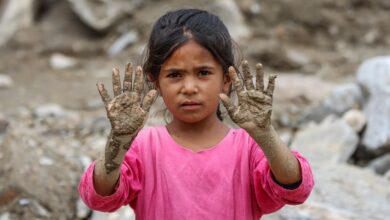Clean, Healthy And Sustainable Environment: A New Human Right
After 50 years of the first Stockholm Earth Summit, the General Assembly of the United Nations (UN) enshrined the universal right to a clean, healthy and sustainable environment .

Photo: Pixabay
LatinAmerican Post | María Fernanda Camisay
Escucha este artículo
Leer en español: Medio ambiente limpio, sano y sostenible: un nuevo derecho humano
Access to a clean, healthy, and sustainable environment is an essential and universal human right. This was endorsed, by a majority, of the General Assembly of the United Nations on July 28 at its official headquarters in New York, United States. Within the framework of this ceremony, each of the Member States was asked to redouble its efforts and join in the collective fight against the triple planetary crisis that threatens the future of humanity. Those who support it say that it is a historic decision to protect the planet. However, it raises many questions. Among them: what role do the governments of the countries play in the face of such a declaration?
Alert! planet in crisis
The health of the planet is deteriorating faster than feared. And this agreement comes at the precise moment in which the Earth is experiencing three major environmental problems simultaneously: climate change, loss of biodiversity, and pollution, all of which are included in the resolution of the UN General Assembly.
No matter what corner of the world we find ourselves in, no one is safe from the increasingly obvious consequences of climate change. The temperature increases, the sea level rises, the ice caps melt, droughts intensify, the oceans acidify, the forests burn and biological diversity disappears. The effects of climate change have escalated in magnitude and it is quite clear that urgent action is needed.
Similarly, the Intergovernmental Platform on Biological Diversity and Ecosystem Services (IPBES) warns of the risk of extinction of one million species of plants and animals, which are crucial for food supply, access to drinking water and the life of natural environments, as we know it.
The World Health Organization (WHO) points out that human beings are not immune to all the changes that the planet is undergoing. In fact, it is estimated that about 24% of annual deaths are due to environmental causes, mainly air pollution and exposure to hazardous waste.
Also read: 99% of Humanity Breathes Polluted Air
Given these alarming circumstances, the recognition of the right to a healthy environment is hopeful news in times of great challenges that urges countries to take effective measures and fulfill environmental commitments, many times delegated.
Certainly, this decision is expected to serve as a springboard to implementing transformative policies that protect people and nature. At the same time, they provide limits of coexistence with a sustainable economic model and support tools for groups or organizations that protect the environment.
In other words, "the UN resolution conveys the message that no one can take away nature, neither clean air nor clean water, nor deprive us of a stable climate. At least not without fighting for it", said Inger Andersen , Executive Director of the United Nations Environment Program (UNEP).
And finally, the day came
After five decades of tireless work, this resolution pays tribute to the hard work of non-profit associations, indigenous peoples, businesses, activists, environmentalists, and various individuals who strongly advocated for the full global recognition of this right.
Since its appearance at the first United Nations Conference on the Environment, held in Stockholm in 1972, environmental issues began to rise to the top of the international agenda. Common criteria and principles were established to care for and preserve the planet. At the same time, institutional mechanisms have been created that coordinate the protective responses of the different countries, such as the UNEP.
It was at that time that the member states of the UN declared that all people have the right to a quality environment, unequivocally marking the beginning of long debates and constant struggles for it to be recognized as such. However, the process was gradual, and little by little it was incorporated into national legislation and regional agreements.
Until, finally, in the month of October 2021, the Human Rights Council -the main body of the UN- ratified it as a right and asked the UN General Assembly, a structure of lower rank, but with greater scope, to also be involved, giving it the universal character.
It should be noted that the recognition of the right to a healthy environment, both by the General Assembly and the rest of the UN hierarchies, is not legally binding. In other words, the member countries have no legal obligation to comply with them.
Still, such resolutions are often “catalysts for action and empower civil society to hold their governments to account in a way that is very powerful,” said David Boyd, the United Nations Special Rapporteur on human rights and the environment.
Building a safe and fair home
In order to achieve the effectiveness and guarantees for this fundamental human right, the Secretary General of the United Nations, Antonio Guterres, stated that countries must implement this right so that it becomes "a reality for everyone, everywhere" and that implies, inevitably, acting on several fronts.
The UN highlights four main points that all States must consider:
- In the first place, it mentions that adequate management of chemical products and waste is a priority to avoid dangerous sources of contamination that affect societies and the environment.
- Secondly, it stresses that it is necessary to inform, train and encourage the participation of citizens in environmental issues. Having timely data allows us to make better decisions in the face of the circumstances that occur around us.
- On the contrary, if the damage has already been done, it will be necessary to guarantee the right to an effective remedy. This right is well established in the international framework and, in general, most local legislation contemplates it and offers some type of compensation to all victims of environmental damage.
- Finally, it concludes on the importance of establishing a comprehensive system that optimizes and supports global efforts with the aim of not only achieving sustainable development but also protecting the rights of each of the human beings that inhabit the planet.




